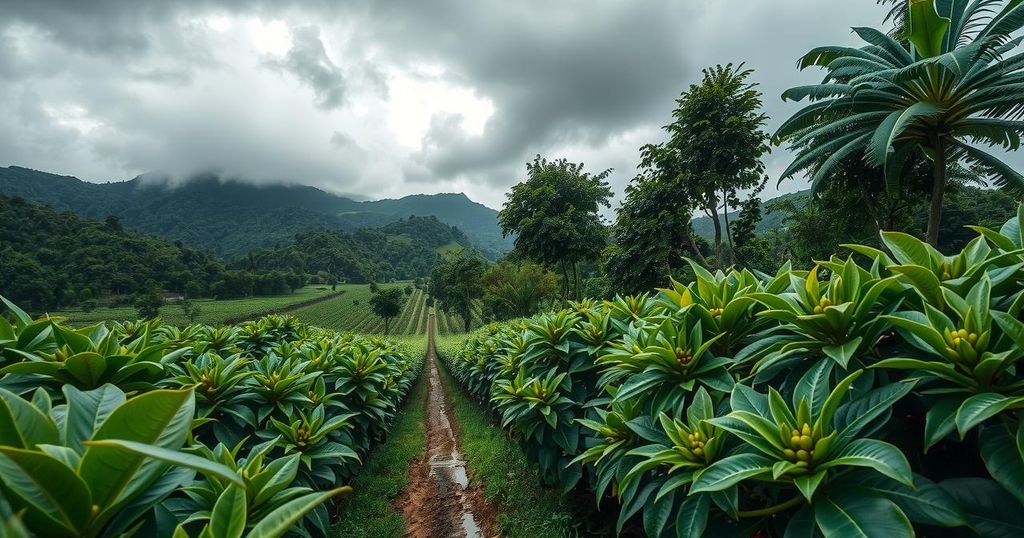Arabica Coffee Prices Surge Amid Drought Concerns in Brazil

Arabica coffee prices are rising, attributed to insufficient rainfall and adverse weather conditions in Brazil. Meanwhile, robusta coffee prices are declining due to increased inventories. Supply concerns persist as both Brazil’s exports and production estimates decrease, contrasting with positive export news from Vietnam. Forecasts indicate future deficits in arabica coffee supplies, complicating the market dynamics.
Coffee prices exhibited mixed trends today, with May arabica coffee rising by 0.30 cents to reach a two-week high. This increase follows reports of insufficient rainfall in Brazil, which poses a threat to coffee crops, thereby positively influencing prices. Specifically, the Minas Gerais region received only 30.8 mm of rain, which is approximately 71% of its historical average, raising concerns about the negative impact on average yields this year.
Conversely, robusta coffee prices declined, surrendering earlier advances after reports indicated a rise in inventories to a one-and-a-half-week high of 4,336 lots. Simultaneously, arabica coffee inventories decreased to a three-and-a-half-week low of 782,648 bags. This dynamic underscores the market’s reaction to ongoing supply concerns affecting coffee prices.
Recent reports highlight a drop in Brazil’s green coffee exports, which fell by 12% year-over-year in February, totaling 3 million bags. Additionally, Brazil’s government crop forecasting agency, Conab, has reduced its production estimates for the 2024 and 2025 crops, suggesting a significant decrease in output due to adverse weather conditions.
Marex Solutions projects the global coffee surplus for the 2025/26 season to expand to 1.2 million bags, a stark contrast to the previously estimated surplus of only 200,000 bags for the current season. Market sentiments are further influenced by favorable production outcomes from Vietnam. The nation reported a 6.6% increase in coffee exports for February, enhancing its robusta production figures.
The El Niño phenomenon has inflicted long-term damage on coffee crops in South and Central America, with Brazil experiencing its driest weather in over four decades. The impactful dry conditions have significantly affected Brazil’s arabica coffee yields, damaging trees during crucial growth stages. Colombia, although recovering, still feels the effects of El Niño-induced droughts.
Robusta coffee prices remain under pressure due to decreased production levels in Vietnam, which has reported a 20% reduction in output for the 2023/24 crop year. Projections indicate that this trend may continue into the 2024/25 marketing year, with further declines anticipated.
Global export dynamics are influencing coffee prices as well, with a recorded eight-month high in Brazil’s coffee exports. Yet, the International Coffee Organization indicates an overall decline in global coffee exports for the latter months of 2023.
The USDA’s recent reports present a mixed outlook: while they anticipate an increase in global coffee production for 2024/25, they also predict declining coffee inventories to a 25-year low. Furthermore, projections for Brazil’s future coffee crops raise concerns about sustainability amidst ongoing drought conditions.
Volcafe has lowered its estimates for Brazil’s arabica coffee production, highlighting the serious impact of prolonged droughts. These challenges are expected to lead to a widening deficit in global arabica coffee availability going into 2025/26, as market conditions remain volatile.
In summary, arabica coffee prices are climbing due to adverse weather conditions in Brazil, specifically insufficient rainfall affecting crop yields. Concurrently, robusta coffee has declined. Supply concerns persist amid falling exports from Brazil and production challenges in Vietnam. Additionally, projections indicate significant reductions in future yields, leading to a potential widening deficit in global arabica coffee supplies. Overall, these factors contribute to a complex landscape for coffee prices in upcoming seasons.
Original Source: www.nasdaq.com






